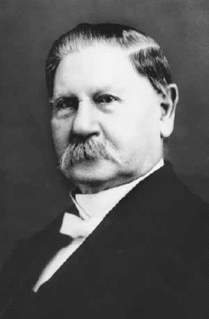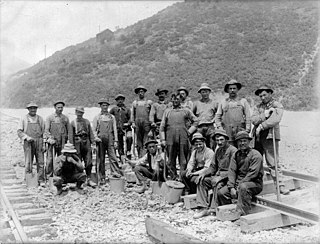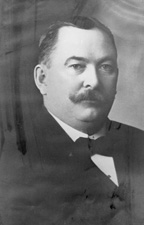Activities
The party attracted a variety of non-Mormon, lapsed Mormon, and ex-Republican politicians and was endorsed by the Salt Lake Tribune. Between 1905 and 1911, the party controlled the municipal governments of Ogden and Salt Lake City. [2] In 1905, party co-founder Ezra Thompson was elected mayor of Salt Lake City, with fellow party members W. Mont Ferry, Arthur J. Davis, Lewis D. Martin, and Martin E. Mulvey elected as city councilors. [3] (Thompson had previously served as a Republican mayor of Salt Lake City from 1900 to 1903.) Thompson resigned in 1907 and he was replaced by new party leader John S. Bransford, who was re-elected in 1907 and was mayor until 1911. [3]
In 1908, the American Party ran John A. Street for governor of Utah. [4] Central platforms of the party were that the leaders of the LDS Church were still participating in plural marriage and had no intention of abiding by the 1890 Manifesto. [4] The party also alleged that the LDS Church monopolized lines of business within Utah and that the state needed a more vigorous enforcement of the separation between church and state. [4]
In 1909, the party opposed a state bill that would have instituted Prohibition in Utah. The LDS Church did not formally support the prohibition bill, but many of its top leaders did.

Reed Smoot was an American politician, businessman, and apostle of The Church of Jesus Christ of Latter-day Saints. First elected by the Utah State Legislature to the U.S. Senate in 1902, he served as a Republican senator from 1903 to 1933. From his time in the Senate, Smoot is primarily remembered as the co-sponsor of the 1930 Smoot–Hawley Tariff Act, which increased almost 900 American import duties. Criticized at the time as having "intensified nationalism all over the world" by Thomas Lamont of J.P. Morgan & Co., Smoot–Hawley is widely regarded as one of the catalysts for the worsening Great Depression.

Mormon fundamentalism is a belief in the validity of selected fundamental aspects of Mormonism as taught and practiced in the nineteenth century, particularly during the administrations of Joseph Smith, Brigham Young, and John Taylor, the first three presidents of The Church of Jesus Christ of Latter-day Saints. Mormon fundamentalists seek to uphold tenets and practices no longer held by mainstream Mormons. The principle most often associated with Mormon fundamentalism is plural marriage, a form of polygyny first taught in the Latter Day Saint movement by the movement's founder, Smith. A second and closely associated principle is that of the United Order, a form of egalitarian communalism. Mormon fundamentalists believe that these and other principles were wrongly abandoned or changed by the LDS Church in its efforts to become reconciled with mainstream American society. Today, the LDS Church excommunicates any of its members who practice plural marriage or who otherwise closely associate themselves with Mormon fundamentalist practices.

The Salt Lake City Council Hall is currently home to offices of the Utah Office of Tourism and the Utah Film Commission and is located on Capitol Hill in Salt Lake City, Utah. Built in 1864-66, the building is historically important as the Old Salt Lake City Hall or just Old City Hall from 1866 to 1894. It was designated a National Historic Landmark in 1975, as an emblem of the conflicts between the governments of the Utah Territory and the United States in the 19th century.

The Salt Lake Tribune is a newspaper published in the city of Salt Lake City, Utah. The Tribune is owned by The Salt Lake Tribune, Inc., a non-profit corporation. For almost 100 years, it was a family-owned newspaper held by the heirs of U.S. Senator Thomas Kearns. After Kearns died in 1918, the company was controlled by his widow, Jennie Judge Kearns, and then the newspaper's longtime publisher was John F. Fitzpatrick, who started his career as secretary to Senator Kearns in 1913 and remained publisher until his death in 1960. John W. Gallivan, nephew of Mrs. Kearns, joined the Tribune in 1937 and succeeded Fitzpatrick as publisher in 1960, remaining as chairman until the merger with TCI, Inc. in 1997.

Charles William Penrose was a member of the Quorum of the Twelve Apostles of The Church of Jesus Christ of Latter-day Saints from 1904 to 1911. Penrose was also a member of the First Presidency, serving as a counselor to church presidents Joseph F. Smith and Heber J. Grant from 1911 until his death.

The Liberal Party was a political party established in the latter half of the 1800s in Utah Territory before the national Democrats and Republicans established themselves in Utah in the early 1890s.

The 1890 Manifesto is a statement which officially advised against any future plural marriage in The Church of Jesus Christ of Latter-day Saints. Issued by church president Wilford Woodruff in September 1890, the Manifesto was a response to mounting anti-polygamy pressure from the United States Congress, which by 1890 had disincorporated the church, escheated its assets to the U.S. federal government, and imprisoned many prominent polygamist Mormons. Upon its issuance, the LDS Church in conference accepted Woodruff's Manifesto as "authoritative and binding."

The Reed Smoot hearings, also called Smoot hearings or the Smoot Case, were a series of Congressional hearings on whether the United States Senate should seat U.S. Senator Reed Smoot, who was elected by the Utah legislature in 1903. Smoot was an apostle in The Church of Jesus Christ of Latter-day Saints, one of the top 15 leaders of the church. The hearings began in 1904 and continued until 1907, when the Senate voted. The vote fell short of a two-thirds majority needed to expel a member so he retained his seat.

Abraham Owen Smoot was an American pioneer, businessman, religious leader, and politician. He spent his early life in the Southern United States and was one of seven children. After being baptized a member of the Church of Christ, predecessor to The Church of Jesus Christ of Latter-day Saints, Smoot served as a missionary in Kentucky, Tennessee, South Carolina, and England. He received no formal education, but learned to read as a child and later attended the School of the Prophets in Kirtland, Ohio. Like other early members of the LDS Church, Smoot practiced plural marriage, eventually marrying six women and having 24 children. After migrating west to Utah Territory, he was elected as the second mayor of Salt Lake City and maintained this position from 1857 to 1866. He was then assigned by Brigham Young to move to Provo, where he served as stake president and mayor from 1868 to 1881. He assisted financially in the construction of the Provo Tabernacle—today the Provo City Center Temple—as well as that of the Utah Southern Railroad. Smoot was the first president of the board of trustees of Brigham Young Academy (BYA)—which later developed into Brigham Young University (BYU). He was an early financial supporter of the institution and was nicknamed the "foster father" of the Academy. His goal was to make education available to young Latter-day Saints. Today, the Smoot Administration Building at BYU is named after him.

Frank Jenne Cannon was the first United States Senator from Utah, who served from 1896 to 1899.

Thomas Kearns was an American mining, banking, railroad, and newspaper magnate. He was a US Senator from Utah from 1901 to 1905. Unlike the predominantly Mormon constituents of his state, Senator Kearns was Catholic.

The Edmunds Act, also known as the Edmunds Anti-Polygamy Act of 1882, is a United States federal statute, signed into law on March 23, 1882 by President Chester A. Arthur, declaring polygamy a felony in federal territories. The act is named for U.S. Senator George F. Edmunds of Vermont. The Edmunds Act also prohibited "bigamous" or "unlawful cohabitation", thus removing the need to prove that actual marriages had occurred. The act not only reinforced the 1862 Morrill Anti-Bigamy Act but also made the offense of unlawful cohabitation much easier to prove than polygamy misdemeanor and made it illegal for polygamists or cohabitants to vote, hold public office, or serve on juries in federal territories.

The "Second Manifesto" was a 1904 declaration made by Joseph F. Smith, the president of The Church of Jesus Christ of Latter-day Saints, in which Smith stated the church was no longer sanctioning marriages that violated the laws of the land and set down the principle that those entering into or solemnizing polygamous marriages would be excommunicated from the church.

Possibly as early as the 1830s, followers of the Latter Day Saint movement, were practicing the doctrine of polygamy or "plural marriage". After the death of church founder Joseph Smith, the doctrine was officially announced in Utah Territory in 1852 by Mormon leader Brigham Young. The practice was attributed posthumously to Smith and it began among Mormons at large, principally in Utah where The Church of Jesus Christ of Latter-day Saints had relocated after the Illinois Mormon War.

Ezra Thompson (1850–1923) was the 12th and 14th mayor of Salt Lake City, Utah, USA, who was elected three times and served two non-consecutive terms. He was mayor from 1900 to 1903 and 1906 to 1907.
John Samuel Bransford was the 15th mayor of Salt Lake City, Utah from 1907 to 1911.
William Montague Ferry was an American politician. He was a Utah State Senator and the 17th mayor of Salt Lake City.

Early in its history, The Church of Jesus Christ of Latter-day Saints had a series of negative encounters with the United States federal government. This led to decades of mistrust, armed conflict, and the eventual disincorporation of the church by an act of the United States Congress. The relationship between the church and the government eventually improved, and in recent times LDS Church members have served in leadership positions in Congress and held other important political offices. The LDS Church becomes involved in political matters if it perceives that there is a moral issue at stake and wields considerable influence on a national level with over a dozen members of Congress having membership in the church in the early 2000s, and about 80% of Utah state lawmakers identifying as Latter-day Saints.
The portrayal of Mormons in comics includes anti-Mormon political cartoons from the 19th and 20th centuries as well as characters in comics who identify as Mormon. In addition, various artists have made comic book versions of parts of the Book of Mormon.













